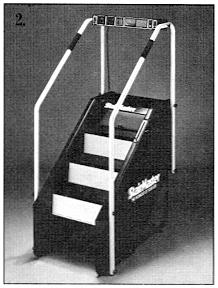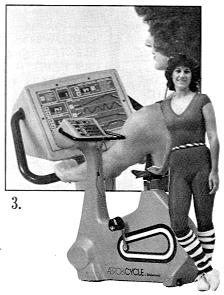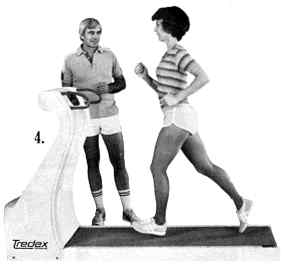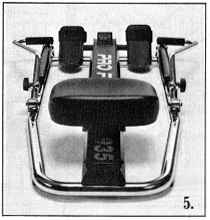MÉNAGE
by Michael A. Graziano
Michael A. Graziano holds a bachelor of science degree in computer technology. He is the author of The Cat's Meow, a book on how to computerize your home.
Electronic intelligence is inhabiting our homes in forms other than the familiar personal computer. With a little help from the microprocessor, common household devices are coming alive with useful and only occasionally frivolous capabilities.
Utilizing a high number of very tiny electronic components in a very small space, microprocessors provide cheap, efficient performance of jobs that would ordinarily require extremely complex and expensive circuitry. Memory control generally is involved in tasks that require the same action or actions to be repeated again and again, as in the operation of washing machines and microwave ovens. Feedback control is used in tasks that need to be monitored or "looked at" in order to maintain some state of equilibrium, such as automatic watering of the lawn, wherein the microprocessor looks at the moisture content of the soil, compares it to a predesignated level and controls the lawn sprinkler accordingly. Time control comes in when a task depends on the time of day, as in turning the downstairs lights on when you come home from work and off again after you've gone to bed.
From Tunes to TV
Touring a typical microprocessor-controlled home will allow us to examine these functions more closely.
Arriving at the front door, we ring the bell. No simple ding-dong in this home; instead a microprocessor-controlled doorbell emits a short chorus of Brahms' Lullaby. Or perhaps it's the theme from Star Wars. Microprocessor-controlled doorbells offer over twenty tunes, easily selected and changed at will.
In the hallway the first device we see is a thermostat, used to control both heating and cooling. It's a bit "fancier" than the simple units we're used to seeing, and upon closer inspection we find that this thermostat is "intelligent"; that is, it has a microprocessor. During the winter months it can be set (or programmed) to regulate the temperature of the house relative to the hour, day of the week, outside temperature, or all three. Another of its features is that the heat is turned down by five to fifteen degrees during the sleeping hours, then raised to a comfortable level just prior to the first human stirrings in the morning. Air-conditioning control during the summer months is just as easy.
Next comes the living room, where we are struck by the picture on the television screen-vibrant with full, rich color. A closer look reveals the secret of the color stability of this TV: a microprocessor is making use of the broadcast stations' VIR (vertical interval reference) signals that contain information as to exactly how the color is supposed to look for each channel. The lack of a channel selector knob on the set is also courtesy of the microprocessor. Channels are simply programmed in once, and from that point on the micro takes care of channel selection and fine tuning. Even the "vertical hold" control, once found on every TV set, is gone forever.
In time, "digital TV" will take full advantage of the intelligence within microprocessors. In this revolutionary method of television broadcasting, the picture to be transmitted is broken up into numbers (from 1 to 255), then sent over the air in the form of digital "bits" of information. The microprocessor in the TV then reconverts these information bits back into a picture with clarity that will make today's best color TV picture look dreary by comparison.
Next to catch our eye is the stereo system. "Microprocessor-controlled," the name plate reads, in this case meaning all we have to do is designate which songs we want to hear on the LP records and which ones we'd like the stylus to "skip over." (Naturally, the same convenience applies to the cassette tape system.)
On our way to the kitchen we pass a telephone answering machine, microprocessor-controlled so that it can respond to calls with several different messages, inform a caller to try again at a certain time, or turn off should the party hang up. The machine also allows us to keep track of our messages by calling home and holding a small beeper next to the phone.
Domestic Digitals
Normally not a very exciting place in the home, the kitchen takes on new dimensions with micro power. Red LEDs (light emitting diodes) on the refrigerator glow to alert us that someone has left the door open and the temperature is rising to the "unsafe" zone. The bright blue digital clock on the microwave oven, having automatically defrosted and cooked the chicken tetrazzini, is now keeping it hot for dinner at seven sharp. Another digital clock on the dishwasher tells us that this appliance, too, is operated under the watchful eye of a microprocessor. We load it up with dishes, tell it what time to start washing, and walk away.
On we move to the master bedroom, certainly not a room in which you would expect to find many high-tech devices. But as the glowing numbers of the clock-radio indicate, intelligence is at work here. Besides simply telling us the hour, this clock-radio can be programmed to wake us up at different times on different days, to give us the correct time in a human-like voice, and even to turn on the morning coffee.
As we head out to the garage, another digital clock peers out at us from a utility closet. This one is an electronic timer that automatically turns house lights on and off at specified times or at random (to give an empty house that "lived in" look). A security system is also nearby, computer-controlled to activate or deactivate automatically, dial the police in case of intrusion and sniff the air for a hint of smoke.
The garage seems bare of micro devices, but that late-model car parked inside could hide some very high-tech equipment. In fact, we find that it contains a trip computer to keep tabs on miles per gallon, miles to drive to "empty," etc. And under the dash glow the red numbers of an anti-theft system that offers complete intrusion/theft monitoring and allows deactivation only by a secret code hidden deep within the microprocessor's memory.
But wait, gadgets are not the only evidence of automotive micro power. Lifting the hood, we discover that the engine's air/fuel mixture, ignition timing and pollution control devices are each tightly regulated under the careful supervision of still another microprocessor.
Our tour ends here, but suddenly the phone rings as we prepare to leave the grounds. Out on the sidewalk we could take it (via a microprocessor-controlled cordless telephone) but we decide to let the answering machine do its job. After all, that's what microprocessor-controlled devices are all about.
"RALPH IS GOING POTTY" My Apple-controlled home is an example of just how far you can go with micro power. It's been operating since 1978 and literally does everything from waking me up to keeping track of Ralph, my cat. Utilizing detectors that gather information in various areas of the house, the computer can sense daylight, rain, vehicle movement, intrusion and fire. After digesting this data, it can then decide what, if any, action should be taken. For example, if its detectors sense rain at 6:30 A.M. (the time I get up), the computer will awaken me with the usual "Good morning, Mike" and tack on "Take an umbrella today." With automation I've achieved total control over the heating and cooling units, with a substantial energy saving as a result. And since the inside and outside temperature, day of the week, time of day and whether anyone is at home (or will be shortly) are all known quantities, the computer can easily adjust the systems for maximum efficiency. A "tickler" file is also checked each morning and evening, and I am reminded, via an eerie, human-like voice, to pay the phone bill or to be at the dentist's by four o'clock. The synthesized voice can speak to me over the telephone, too, and can answer a ring of my doorbell or say "Hi, Ralph" at random times to keep my cat happy. Yes, Ralph, too, has entered the computer age. She is the user of the world's first computerized litter box. An enclosure has been built around her latrine, and mounted inside the door is a sensor that can detect Ralph's presence when she enters and make a note of the date and time. After allowing her a few minutes of privacy, the computer turns on a ventilator fan to scatter any odor outdoors; twenty minutes later, the fan is turned off to await Ralph's next guest appearance. To add a bit of the human touch, the computer speech synthesizer announces each entrance with the words: "Ralph is going potty." Speakers installed in every room ensure that all humans within earshot are made aware of the historic event. Why keep track of the date and time of Ralph's comings and goings? Because when I'm on vacation, I can call home and request the time of Ralph's last restroom visit. If it's recent, I can rest assured that all is well. If not, she may be ill, and I can contact a neighbor to check on her. M.A.G. |
| COMPUTERIZED FITNESS Now an array of "intelligent" exercisers can help you jog, row, bike-and even improve your golf game-without leaving home! Maintain your shape and your privacy with the same workout you'd get at the health club while you take the "out" out of workout. 1. Thanks to the Video Fitness System from Garden & Green Co., you can get fit while you play your favorite computer game. Hook up the VFS to your game console or home computer, and use your whole body as you play. Sensors in the VFS translate your body movements into instructions to the game, so you have to exercise your body-doing a sit-up, for example, to blast an asteroid. The VFS has routines for aerobic conditioning and weight control, flattening the stomach and trimming the hips and thighs.  2. Computers are also providing .stepped-up exercise, quite literally. The StairMaster (from Tri-Tech, Inc.), an electronic staircase, lets you key in your goal in terms of number of flights, then helps you get there. The chest-level membrane console tells how you're doing by emitting encouraging beeps as you pass each floor; when you make it to the "top," it lets out a satisfying long signal. Your pulse is constantly monitored, and there are six different settings for varied resistance. A bonus feature is a chart that lists fifteen international landmarks, their heights and number of floors. The challenge is implicit. Scale such wonders as the Statue of Liberty (thirty-four floors), Washington Monument (fifty-five) or Hoover Dam (seventy-two), or hit the top of the CN tower in Toronto (one hundred and fifty-nine).  3. Hop on Universal's computerized, magneto-powered Aerobicycle, featuring five preprogrammed exercise modes. "Constant rotation" keeps you pedaling at an even pace; "steady climb" provides constant resistance; "rolling hills" lets you change terrain by varying the resistance at random; "pulse training" automatically readjusts the resistance to match your efforts. Your pulse is monitored along the way, and there's a display of the calories you're burning off. The final mode is a fitness test that ranks you with the national YMCA norms according to sex, age and aerobic fitness level.  4. Stop going around in circles! This . electronic running track, the Amerec 930e, uses optic sensors placed under the running belt and an LED display panel set into a membrane keyboard at chest level to monitor your efforts. The sensors indicate your speed within .1 m.p.h., the distance covered, and your time, all available at once or one element at a time for continuous monitoring.  5. The world's first electronic rower, .the Proform 935, features an LCD control panel that sits within easy reach between the footrests and offers a choice of four audio tones with which to pace yourself. Program in your desired speed in strokes per minute, pick your tone-and you're off, timed and paced, with a constant record of your speed and completed strokes.  |
Return to Table of Contents | Previous Article | Next Article

